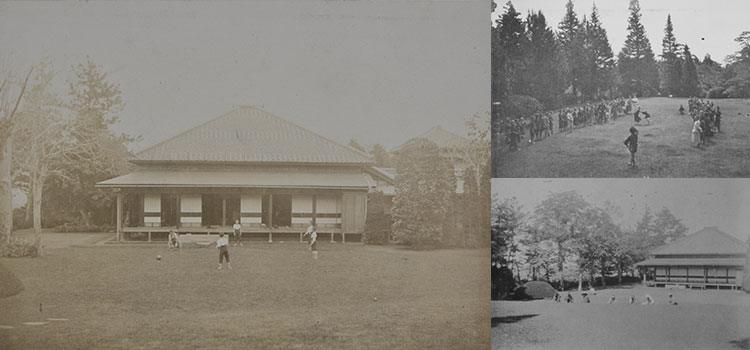Old Akitake Tokugawa Garden: a nationally designated Site of Scenic Beauty

The lawn garden incorporates western-style techniques, and extends out from the west side to the south side of the central buildings. The shoin garden, designed to be viewed seating in front of the shoin pillar, was initially laid out between 1884 and 1887, then expanded twice in 1887 and 1890. The planting was completed in 1891.
According to the old photographs taken when Akitake Tokugawa lived here, a grove of Japanese umbrella - pine trees on the east side and a grove of Chinese parasol trees on the west side were divided by the lawn. Crossing the pine tree grove in the southwest direction also led to another garden. The lawn surface is the oldest of its kind in Japan, developed using Western-style techniques. There are no similar instances of the technique in which tree groves have been adopted as the main scenery. Another highlight of the garden is the view of the Edogawa River and of Mt. Fuji, as seen in a westerly direction from the central buildings.
The various elements are described below.
The Old Akitake Tokugawa Garden (Tojo-tei Garden) is divided into the Front Garden, Shoin Garden (Main Garden), Arbor Garden, Living Room Garden, Courtyard, Detached Parlor Garden, Envoy's Quarters Garden, and Courtyard (in front of ticket office). The next section provides explanations about the four main gardens.
■Front Garden This is now only the area between the thatched gate and the entrance, but originally the slope below the gate was the entrance to the estate, and so the Front Garden included this area as well. Akitake placed a thatched gate at the end of the sloping path leading through the cedar forest, inspired by Nishiyama-so, the house Tokugawa Mitsukuni, the second Mito Tokugawa lord, retired to. The spinney of sawara cypress trees in front of the entrance and the stepping stone of whitish marble are believed to have been inspired by Kairaku-en Garden and Kodokan, created by Akitake's father Nariaki, the ninth Lord of Mito.
■Main Garden The Main Garden was designed to be a shoin-style garden to be viewed from the position of honor in front of the tokonoma in the Guest Room. The lawn that spreads out over the garden from around the area under the south and west eaves of the Parlor building gives the appearance of one of the Western-style gardens that were common in the Meiji period, but the artificial hill that is its main feature is characteristic to this garden. South and east of the hill is a grove of Japanese umbrella pines, and to the west is a grove of Chinese parasol trees. The grove of Chinese parasol trees has been spaced out so that when seen from the place of honor in front of the tokonoma in the Living Room, Mt. Fuji can be seen in the far distance as a form of borrowed scenery. The choice of tree species also may have a meaning, with the Japanese umbrella pines representing the House of Tokugawa, and the Chinese parasol trees representing respect for the emperor. South of the Chinese parasol trees is a grove of pines running down to the Ardor Garden. There are no other Western-style gardens in Japan with groves of conical trees. Here, they combine with the naturalistic shapes of the pines to form what could be termed a compressed landscape garden.
This Main Garden is a distinctive Western-style garden incorporating landscape garden elements, and is considered the oldest remaining Western-style residence garden in Japan.
■Living Room Garden The garden in front of Akitake's living room is connected to the western side of the shoin-style Main Garden. There are a large stepping-stone of Nebukawa stone, a hand basin, and decorative rocks alongside the building. A thick Japanese maple in a planter has been grown to keep the setting sun off. In contrast to the expansive Western-style Main Garden, the Living Room garden is only two bays wide, but is a traditional Japanese-style garden.
■Ardor Garden This was designed as a pleasure garden, focusing on the arbor, built in the middle of the pine grove running south from the western side of the shoin-style Main Garden. The arbor, standing on high ground looking over the Edogawa River, offers views to Mt. Fuji to the west and Mt. Nantai to the north. Somei-Yoshino cherry trees, Japanese maples, and other plants have been grown to provide enjoyment throughout the four seasons from their flowers, fresh greenery, and autumn leaves. A climbing kiln is believed to have once stood southeast of the arbor, on the slope across the narrow dell.

